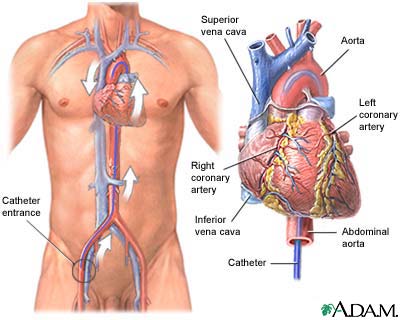Cardiac Catheterization procedure - definition, complications and risks

Cardiac Catheterization is a diagnostic or therapeutic procedure in which the cardiologist inserts a long, flexible, thin tube into an ARTERY near the surface of the SKIN and threads it through the artery into the HEART or the CORONARY ARTERIES. The cardiologist uses FLUOROSCOPY (moving X-RAY) to view the progress of the catheter’s insertion via closed-circuit television. During cardiac catheterization the cardiologist typically injects dye into the coronary arteries to visualize the flow of BLOOD through them (cardiac ANGIOGRAM).
Reasons for Doing This Test
Cardiac catheterization helps diagnose CORONARY ARTERY DISEASE (CAD) and the extent of coronary artery occlusion (blockage). The cardiologist also may use cardiac catheterization to diagnose damaged or dysfunctional heart valves and biopsy the endomyocardium (inner lining and MYOCARDIUM of the heart). Therapeutic applications of cardiac catheterization include ATHERECTOMY and percutaneous transluminal coronary angioplasty (PCTA), also called balloon ANGIOPLASTY. In PCTA the cardiologist inflates a tiny balloon at the catheter’s tip to compress ATHEROSCLEROTIC PLAQUE that is occluding a coronary artery.
Preparation, Procedure, and Recovery
Cardiac catheterization requires little preparation beyond nothing to eat or drink for six to eight hours before the scheduled procedure. The catheterization takes place in a sterile setting. Because there is a slight risk for complications that would require immediate OPEN HEART SURGERY, the catheterization facility has full operating room and surgical team capacity. At the start of the procedure the cardiologist administers a general sedative to help the person relax, and injects a local anesthetic into the tissues around the area where the catheter will enter the artery. The cardiologist makes a tiny incision to gain entrance to the artery, and threads the catheter through the artery to the heart and coronary arteries. Typically the cardiologist videotapes the catheterization for further study or review following the procedure.
Depending on the reason for the catheterization and the cardiologist’s findings, the procedure takes 45 to 90 minutes. When finished, the cardiologist withdraws the catheter, sutures the insertion incision, and places a pressure dressing over the wound. The person remains lying down for six to eight hours, in a recovery area, allowing a good clot formation to develop and also permitting the sedative to wear off. Most people are able to go home the same day, though must have a friend or relative do the driving, and can return to regular activities within a week.
Cardiac Catheterization - Risks and Complications
The most significant, though an uncommon, risk of cardiac catheterization is HEART ATTACK or STROKE from atherosclerotic plaque the catheter dislodges. Some people may have a HYPERSENSITIVITY REACTION or allergic response to the injected dye with angiogram. Also uncommon—though possible—is that the cardiologist may discover, upon reaching the occlusion, that the atheroma (plaque formation) is unstable and may determine that immediate CORONARY ARTERY BYPASS GRAFT (CABG) will be necessary. More common complications include bleeding and discomfort at the insertion site or INFECTION after the procedure. For most people, cardiac catheterization is uneventful and provides the information the cardiologist needs to make a definitive diagnosis.
See also STENT; SURGERY BENEFIT AND RISK ASSESSMENT; VALVULAR HEART DISEASE.